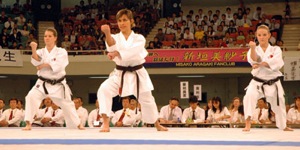KATA

Kata is often the least understood aspect of Karate.
On first sight it is a predetermined sequence of blocks and attacks against multiple imaginary opponents, however the oriental arts are often much more than they seem on first inspection.
Originally Kata were a record of the techniques and skill sets from a particular school or style of karate, and many of the advanced kata date back several centuries. More recent kata, such as the Pinan (or Heian) series, were designed to be training aids which could be taught to the general public in schools and universities as a pure "art" form, yet on deeper inspection they contain some very effective and devastating unarmed combat techniques.
In a traditional karate club Kata is often perceived as a way of practicing techniques on your own. And, yes, you can use Kata as a very effective form of solo training, especially since the blocks and strikes involved in the sequences tie in with the techniques being practiced at your own level of expertise. When you practise a green belt Kata, for example, you are also practising the green belt blocks, strikes and kicks that are required in the grading examinations.
Each time you advance to a higher grade the Kata increase in complexity and length. At a high level of proficiency Kata requires a certain "mental" input to be performed well. The Kata moves on from being merely sequences of movements to an art form and a form of moving meditation. A Kata performed well is more taxing, physically and mentally, than a three minute sparring session with a real opponent, and is a pleasure to watch. Kata is also the ultimate challenge in Karate. In Kumite, you can defeat someone with a blow to the head and win your bout, but in Kata you are striving to attain perfection. Your opponent is yourself, so you can never win!
Once you start looking into the deeper meanings of the moves (Kata Bunkai) you will find a myriad of techniques involving throws, strangles, joint locks and breaks - the stuff that most people seem to think karate doesn't do! After decades of practicing a particular Kata it is not unusual to discover a whole new set of facets to the moves that you never noticed before. You can spend a lifetime in the study of Kata and still find yet another layer of meaning!
Sandokai uses the basic Wado Ryu Kata for it's lower grades, Taikyoku (first course) and Pinan Shodan to Pinan Godan ("peaceful", 1 to 5). The high stances and quick, light movements of Wado Ryu promote early competence in the students with the added bonus of some very effective self defence applications.
The senior grades of Sandokai (2nd Kyu brown belt and above) practice the five top competition winning Kata. Brown belts practice Saipai and Seinshin from the Goju Ryu style which contain some frighteningly efficient joint locks and breaks, and Black belts practice Nijushiho, Gojushiho Sho and Unsu from the Shotokan system which contain some extremely powerful techniques.
Every Kata has its own set of lessons for the practitioner, and if you look closer you will see that there is a particular “theme” for each Kata. One Kata will teach you how to deliver a single knockout blow with minimum effort, while another will teach you how to clear away your opponents limbs so you can easily land the knockout blow you learned in the previous Kata.
If nothing else, Kata can be fun, challenging and provide you with a way to express your own personality within your training.
If only we could perform our kata like this.
GRADE REQUIREMENTS
8th KYU - WHITE BELT
TAIKYOKU
7th KYU - YELLOW BELT
PINAN NIDAN
6th KYU - ORANGE BELT
PINAN SHODAN
5th KYU - GREEN BELT
PINAN SANDAN
4th KYU - PURPLE BELT
PINAN YONDAN
3rd KYU - BLUE BELT
PINAN GODAN
2nd KYU - BROWN BELT
SIENSHIN
1st KYU - BROWN BELT
SAIPAI
1st DAN - BLACK BELT
NIJUSHIHO
2nd DAN - BLACK BELT
GOJUSHIHO SHO
3rd DAN - BLACK BELT
UNSU
Note:
All persons taking a black belt grading are also required to perform an advanced kata of their own choice. This kata can be from any style or martial art and it must be performed at a level commensurate with the grade being taken.
All persons taking a black belt grading are also required to perform an advanced kata of their own choice. This kata can be from any style or martial art and it must be performed at a level commensurate with the grade being taken.

